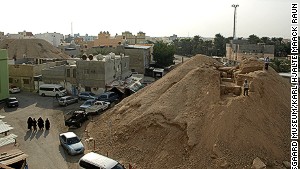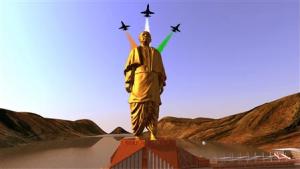The monks followed us out to the parking lot. It was a cool autumn morning, and there was silence inside the Ryongthong Temple, a hillside complex of Buddhist shrines outside the North Korean city of Kaesong. Centuries ago Kaesong was home to Korea’s kings, and Ryongthong was a bustling religious center. But this morning the temple was empty. There were no ringing bells, no worshippers lighting incense—only two monks in gray robes walking through the complex with ostentatious serenity. Down in the city, loudspeakers on Kaesong’s empty main street were bellowing songs of praise for Kim Jong Un, the young man North Koreans now call the Supreme Leader.
Photographer David Guttenfelder and I had come to the temple with our minders—the anxious government bureaucrats who accompany foreign reporters everywhere they go in North Korea. I briefly interviewed one monk, dutifully scribbling a few banalities in my notebook. “Buddhism helps people be clear, clean, and honest,” he said.
A Buddhist temple in North Korea would seem a natural place for a reporter to ask about freedom of worship. Researchers say six decades of a one-family dictatorship have effectively crushed organized religion here. But if I asked, and one of the monks even hinted at any unhappiness with the regime, I knew he would go to prison, disappearing into a hidden gulag that human rights workers say holds between 150,000 and 200,000 people. So I didn’t ask, and we walked out shortly after.
In the parking lot, though, as we slid open the door to the van that ferries us everywhere, the monks reappeared. A minder was beside them. All looked at us expectantly. Then the older monk spoke. “I know what you want to ask,” Zang Hye Myong said.
Suddenly it was obvious why the monks had followed us. Minders do not introduce journalists to dissidents, and Ryongthong was no enclave of political critics. It was, as I should have known all along, a temple of totalitarian fakery, a movie set in which the stone steps and ornate wooden doors were barely worn. The monks were actors in a theatrical performance about North Korea’s religious freedom.
We were the audience.
So I grumbled the question they were waiting for: “Are you free to practice your religion?”
The monk looked victorious. “Westerners believe it is not allowed to believe in religion in my country.” He shook his head sadly. “This is false.” He was proof, he said, of the freedoms given to Koreans by the “Great Leader” Kim Il Sung and now protected by his grandson Kim Jong Un. He looked directly at me to make his final point, as if he’d been practicing the line: “I want you to take the truth to the world.”
But the truth is rarely simple in North Korea. How to make sense of a country where the leader embraces basketball bad boy Dennis Rodman and a week later threatens to let loose an atomic firestorm on the United States? This is a country where the reality of everyday life is kept hidden behind carefully created facades, and most visitors see nothing but a few perfectly paved roads and a handful of monuments to the family—father, son, and now grandson—that has controlled life in North Korea for 65 years.
It’s a country where reporting often feels like a series of strange, bloodless battles. Sometimes—like that morning at Ryongthong—the government wins. But if you stay long enough and look deeply enough, there are days when you learn more than you expected. It’s why we keep coming back.
Over the past year David and I have been part of a small team of Associated Press journalists who have been able to visit North Korea regularly. We’ve traveled to collective farms, attended countless political rallies, and visited Pyongyang hot spots like the Gold Lane bowling alley, where the capital’s elite hoist battered balls made in America. In a country where dull, Soviet-inspired clothing had always been the rule, soldiers’ girlfriends now parade through Gold Lane in short skirts and high heels, thanks to the capital’s small but growing consumer economy.
But for the most part we still see only what our minders, and the powerful government agencies looming silently above them, allow. The minders meet us at the airport when we arrive and drop us off when we leave. Every morning they’re waiting for us in the lobbies of our hotels, behemoths of relative luxury built for foreigners. They are places with reliable heat, electricity, and even Internet access but where guests spend their days lost amid acres of scuffed marble and floor after floor of empty rooms, wanderers in these failed attempts at 1970s Las Vegas elegance.
Our main minder is a pleasant but purposefully distant man named Ho Yong Il. He is with us at the Children’s Department Store and during rallies in Kim Il Sung Square. He goes with us to restaurants and factories. Mr. Ho (he is always Mr. Ho to me) is our translator, our guide, and the man charged with never allowing us out of his sight. If we tried to slip away from him—something we have never tried to do—no doubt our visas would be revoked.
I spent far more time last year with Mr. Ho than with some of my closest friends. Yet after many attempts to get him to open up, here is what I know about him: He studied English. He once saw part of the movie Gone With the Wind. He likes Charles Dickens. His wife is a homemaker.
He is also a patriot. Though he is interested in the larger world, curious about American slang and how David and I work, his reverence for his homeland is obvious. To spend time with Mr. Ho is to see North Korea through the eyes of a believer. He clearly enjoys talking about his country’s history, its leaders, and its monuments. But requests to see something unexpected—to visit a car dealership or watch a university history lesson—are usually met with Mr. Ho’s warning “That might be difficult.” Most of the time that means no—though it’s rarely clear who actually makes the decision.
It’s hard to know how much of what Mr. Ho allows us to see is real. One day he takes us to meet a pair of working-class newlyweds in their new three-bedroom Pyongyang apartment, with its 42-inch flat-screen TV. The apartment is in one of the city’s showcase housing complexes, its outer skin a grid of blue and white bathroom tiles. These upscale towers near the Taedong River were built for the minuscule elite of the long-ruling Korean Workers’ Party, or KWP. But Mr. Ho wants to prove that they’re open to everyone. The couple, we are told, were given the apartment because the wife, Mun Kang Sun, had been declared a Hero of the Republic for her astonishing productivity at a textile factory.
Mun, a demure woman in her early 30s who looks much older, sits quietly as her husband speaks. “All the people of my country are like one big family with the leaders as our parents,” says Kim Kyok, a technician at the same factory. He says his apartment shows how the regime cares for its people. But as he speaks, he picks nervously at his fingers. A trio of people—two minders and a tall, scowling man no one bothers to introduce—is listening to everything. In a country where meeting foreigners without official permission is illegal, the pressure on the couple is clearly immense.
Always there are questions I can’t ask. Do the couple really live in that apartment? If they do, are they required to keep it constantly ready to show to foreigners, a living diorama of Kim Jong Un’s promises to bring prosperity to a people accustomed to poverty and famine? Are their neighbors all from the party elite?
If reporting inside North Korea sometimes leaves David and me with as many questions as answers, it can still offer a rare view into the long-isolated world the Kim family has created. Piece by piece, we are assembling a collection of fragile and often confusing moments into a picture of a country that works hard to make itself difficult to understand.
We’ve learned that what we see in passing is often more revealing than our destination. We’ve found that unguarded moments can be captured in photographs taken from bus windows and that wrong turns can provide revealing details. Like the time our bus driver accidentally veered off a perfectly maintained Pyongyang street onto a narrow, dusty road pocked with potholes and lined with unlit buildings. Or when we spotted a moldy tower of apartments one evening, each room lit by a single naked bulb casting a sickly yellow light. We have ventured outside the relative prosperity of Pyongyang to cities without modern high-rises, where dimly lit stores contain half-empty shelves.
It is necessary to go outside the country—to South Korea, Britain, or China—to find the only North Koreans who can speak freely about the realities of totalitarian life: the ones who have left. “Looking back, I wonder now why we had to live such sad lives,” says a former North Korean coal miner, who fled to Seoul in 2006 because his father was politically suspect. Refugees describe a hidden caste system based on ideological background: Three generations of a family can be imprisoned if one member is convicted of a political crime.
The coal miner is one of about 25,000 North Koreans who have escaped to South Korea since the war. They have fled political repression, an enveloping police state, and desperate poverty. The UN estimates that one-third of North Korean children are chronically malnourished. But the number of refugees has dropped dramatically since late 2011, when Kim Jong Un tightened security along the once porous 880-mile border with China. In 2012 only about 1,500 North Koreans made the dangerous journey.
The North Korean government, of course, works relentlessly to present a view of life in which schools are filled with happy, well-fed children, stores are filled with goods, and loyalty to the Kim family is universal. People know to speak to reporters in surreal, mechanical hyperbole, spouting praise for their leaders. “Thanks to the warm love of the ‘Respected General,’ Kim Jong Un, even rural people like us can come here and enjoy mini-golf,” Kim Jong Hui, a 51-year-old housewife from the country’s remote northeast, tells me one day at the country’s first putt-putt golf course, in Pyongyang. Overwhelmed by this benevolence, she says, “I have made up my mind to do my duty to help build a prosperous, powerful state.”
It is easy, after many such encounters, to believe in the caricature of North Koreans as Stalinist robots. The challenge is to find the far more elusive—and more prosaic—reality. Sometimes that takes stumbling onto a subject that gets North Koreans to open up a bit.
Like Gone With the Wind. This nation revels in the 77-year-old novel, finding echoes of itself in the tale of civil war and the ruthless, beautiful woman who vowed never to go hungry again. More than one million North Koreans are estimated to have died or gone missing in the Korean War, and hundreds of thousands more died in a 1990s famine that tore deep into the country. The government, for reasons never made clear, had the book translated in the mid-1990s, when North Korea was struggling to survive without Soviet aid and the mass starvation was under way.
In a country with few entertainment choices that have escaped the propaganda bureaucrats, the novel gripped the capital. Today it’s hard to find an adult in Pyongyang who hasn’t read it. A guide at the Grand People’s Study House, a musty Pyongyang monolith, sees the book as proof that American women are poorly treated. A Kaesong bureaucrat, a haughty man with a fading blue-striped tie, sees the book as a Marxist morality tale. A woman with a troubled marriage tells me she discovered strength in Scarlett O’Hara’s cold-blooded tenacity. The book is entertainment and solace and inspiration. It’s a window into America. It’s a celebration of a people who, like the North Koreans, are fiercely proud of fighting the Yankees.
You can see that North Korean toughness in the middle-aged women sitting on the ground on a frigid night, seemingly comfortable in cheap cotton overcoats as they watch a fireworks display. You can see the longing for knowledge in Pyongyang, where electricity often disappears without warning and where a late-night drive can find dozens of people downtown, standing under streetlights with newspapers and schoolwork. Even after the bizarre mass rallies and the pledges to die for the motherland end, there are informal gatherings with surprising echoes of small-town America, as gossiping old women and flirting young people fill the streets. Sometimes, though, the truth about ordinary North Korean life is hidden right inside the Potemkin displays.
Like the dancing. I first saw it on a Sunday evening in Pyongyang, in a clearly orchestrated show of uniformity and loyalty, when nearly 500 couples danced in the shadow of three stone fists thrust into the sky. Each fist wielded a tool—a hammer, a sickle, and a pen—that together formed the symbol of the KWP. The men wore short-sleeve shirts and ties. Women wore the filmy polyester dresses that pass here for traditional clothing. They twirled in well-practiced circles and between songs stood silently in pairs. Few people smiled. Most had the blank expressions common at mass rallies, where boredom, resignation, and patriotism often mix together. Officials rushed around, barking at anyone who fell out of step. That night I couldn’t imagine anyone celebrating life with the stiff dances of that staged event.
But a few nights later, at about 2 a.m., I opened my hotel-room window to look out over the city. The streets were empty. There were no security convoys, no movements of soldiers, nothing unusual. I heard music somewhere in the distance. Leaning out, I could see lights blazing at a small building a couple of blocks away.
It was a party. Looking through binoculars, I could see dozens of people gathered in the building’s courtyard. Bottles were being passed around. I could see the orange glow of cigarettes.
Many of the people were dancing. It was the same dance I’d seen a few days earlier, but with the swing and sway of people enjoying themselves. Listening hard, I heard snatches of the same music wafting through the night.
Were they celebrating a birthday? A promotion? A wedding? I’ll never know. But it was a reminder of what goes on when no one knows a journalist is watching.
“We are normal,” a former North Korean black marketeer who now lives in Seoul once told me. “Please don’t forget this. People live, people compete to get jobs, people fight. There are the basic elements of life like there are in South Korea or the United States.”
Or anywhere.
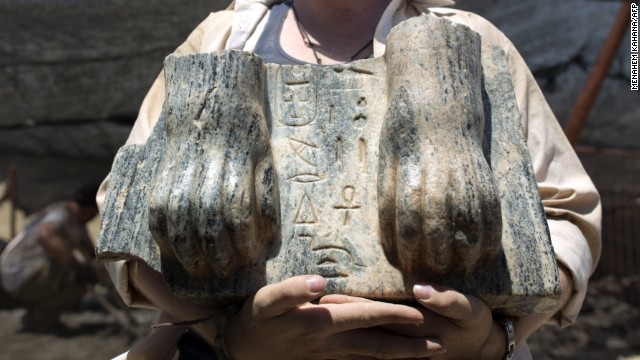
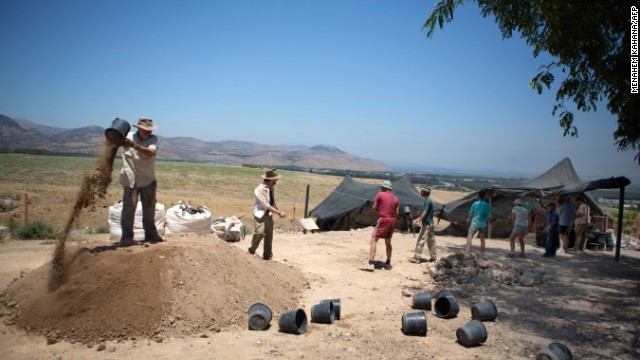 Digging at Tel Hazor
Digging at Tel Hazor
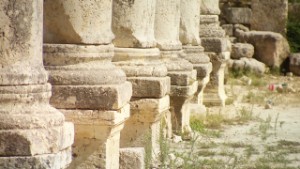 Biblical city fights for survival
Biblical city fights for survival
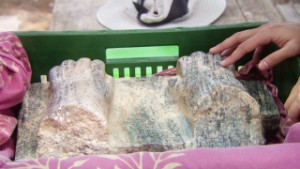 Artifact 'gold mine' rewrites history?
Artifact 'gold mine' rewrites history?
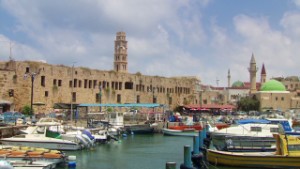 Ancient city holds on to its rich past
Ancient city holds on to its rich past
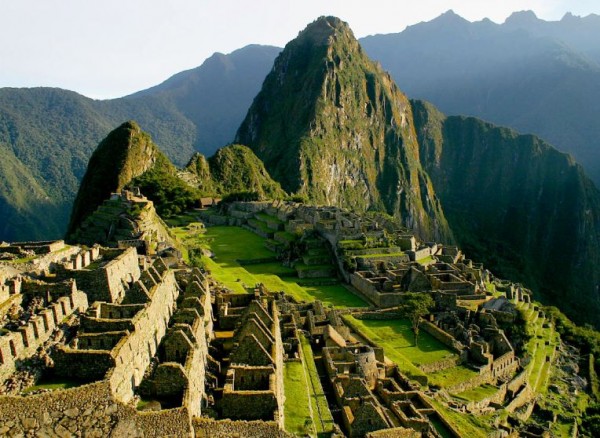
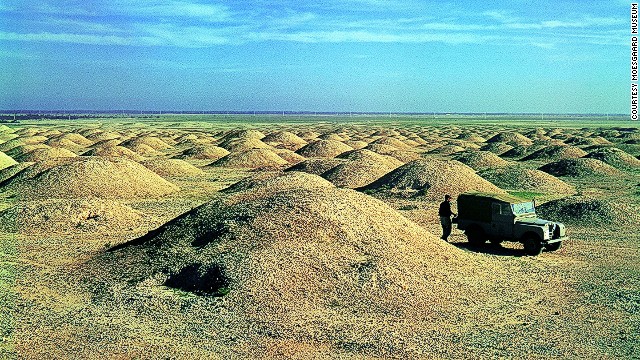 Thousands of 4,000
year-old burial mounds, leftover from the Dilmun civilization, once
covered a third of Bahrain's landmass. The mounds were largely intact
when this picture was taken in 1956.
Thousands of 4,000
year-old burial mounds, leftover from the Dilmun civilization, once
covered a third of Bahrain's landmass. The mounds were largely intact
when this picture was taken in 1956.
